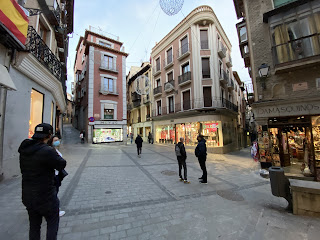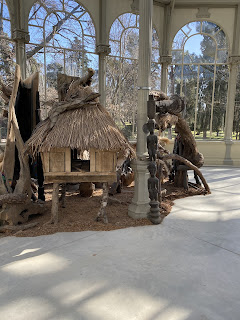Wow! Toledo. I booked a private tour guide for Wednesday to take me through the city and its many sites of interest. I left my apartment in Madrid at 8am and didn’t get back until 9pm - overwhelmed and exhausted. Taking the train, it was a fast 30 minute trip to Toledo. The trains are super fast and smooth here in Spain.
Toledo has had a long history of inhabitants; from the Jews in the 5th Century BCE when several Jewish travelers settled in the area, to the Romans who wrested the area from local Celtic tribes around 193 BCE, then the Moors who invaded and took control of the area in 711 CE. Alfonso VI, Christian ruler of Castile took control of the city in 1085 CE and it remained the Castilian capital of Spain until King Felipe II moved the Royal Court to a very small town called Madrid in 1561, affectively making it the new capital. Because of this complex settlement and resettlement of three different cultures over its history; Jewish, Moslem, and Christian, and the complexity of the three groups living side by side with one another through much of that history, Toledo is known as the city of three cultures. Although none of those three religions mixed with one another, the cultures did and the architecture is astounding, as a result.
The first few pictures are those of Toledo itself which sits above the Tagu River. You’ll see why this was a perfect place for a settlement, as it was harder to access while being easily defensible.
In the first picture, you’ll see the bridge that the Romans built nearly 2000 years ago, which is still used everyday by motorists and pedestrians.
The following three pictures will give you an idea of time frame as seen in the architecture. Although the materials used are the same, the “block” or the stone used between the horizontal layers of brick gets larger through time. The first picture is of one of the only remaining minarets or towers of the original mosque that no longer exists and dates back to the earliest time period - before 711. You’ll notice the very short “block” between the horizontal lines of brick in the tower. The second picture is later from about the 12th Century and that “block” is about double the size from the minaret, and the third picture is newest - perhaps around 14th or 15th Century with an even larger “block” and a double layer of brick.
The next pictures are of a de-consecrated Catholic Church that is now a museum. You’ll notice the Arab influence of the arches and the open upper windows, devoid of stained glass, but rather enclosed with geometric shapes, letting the pure natural light in.
During Toledo’s Christian heyday, there were many convents and monasteries within the city. One of them grew so large that it encompassed over 14 streets within its buildings. Here is a picture of one of the inner courtyards of the largest convent and a model of the convent itself as it is difficult to distinguish from outside.
The following pictures are those of the Toledo Cathedral, known properly as The Primatial Cathedral of Saint Mary of Toledo. Construction of the Cathedral was begun in 1226 but not finished until 1493. It was built over the site of the former Mosque which was completely destroyed by the Christians who invaded and took control of the city in the 11th Century. Remember at one point this was the seat of power for Spain and the Archbishop of Toledo had nearly as much power as the Pope in Rome. You’ll no doubt notice the opulence of this Cathedral simply from the pictures. It is absolutely breathtaking. As I have found so far in many of the Gothic style churches in Spain, there is a large box in the center of the church. This box is called the Choir. Many parishioners sit behind the Choir which blocks all view of the priest and the altar. Only the elite and those of importance were permitted to sit up front between the priest, altar, and the Choir.

These massive doors are known as the King doors and were only opened when the King or Pope came to worship.
To give you an idea of scale the head of a person would only come to the height of St Christopher’s right ankle. He holds the infant Christ on his left shoulder.

Here is the Choir.
In front of the choir.
Behind the Sacristy.
The Monstrance which holds the Sacred Host. It is made of pure gold, silver and adorned with precious gems: diamonds, rubies, emeralds, pearls, etc…commissioned by Queen Isabella who sacrificed some of her own jewelry for its creation.
On the 40 day after Easter, the liturgical feast of the Corpus Christi was implemented by Pope Urban IV. On this feast day, the monstrance is carried in a procession into the streets for the veneration of the faithful. The pedestal of angels on which the monstrance sits was commissioned by the Toledo Cathedral Council in 1741. Since 2016, the monstrance now sits in this exhibition hall within the Cathedral.
My tour guide, Alejandro, and I took a lunch break after visiting the Cathedral at one of his suggested restaurants. The building itself was a fusion of old and new. He told me about the Menu of the Day, which gives you a choices of first course, second course, and dessert or coffee at a fixed price. I had a hot, thick tomato and beet soup for my first course and venison stew for my second. It was cold outside and I needed to get warm! Alejandro also let me try a bit of his own first course which was basically a Spanish stuffing.


Alejandro and I discussed my time in Spain and about my Sabbatical. After hearing why I was there, he was very excited to show me a 16th Century typical family kitchen in Toledo, now on display at the Goya Museum there.
To the right you’ll see that the kitchen cooking area is set in the middle of the floor with built-in benches on either side of it. Cooking and eating were family affairs when everyone gathered together to sit near the fire where it was warm and to talk and enjoy one another’s company.
Alejandro is a native Toledan and an archaeologist by profession. A friend of his in the town wanted to do some work on his basement and in digging found and an original Islamic Hammam, completely intact which must date back to the 6th or 7th Century. It is not open to the public, so I was privileged to be able to see it.
The last building we toured was a synagogue which now houses the Sephardic Museum. This synagogue is quite unique. It was commissioned to be built by Christian King Peter for the Jews in Toledo by the Moslem tradesmen. The decorations on the wall look like tapestries or paintings, but they are carved stucco.
After the tour was over, I wandered the streets of Toledo until it was time to grab the train back to Madrid.
On Thursday, I spent the day in El Retiro Park which I think is the largest public park in Spain. The Crystal Palace, originally constructed as a greenhouse within the park, now houses changing exhibits.
I have a difficult time adjusting to the Spanish timing for dinner, so opted for a late lunch instead inside the park of pork and potatoes.
And finally, I came across this church before heading back to the apartment for a nap and to write today’s blog that would cover the last two days.




















































































No comments:
Post a Comment